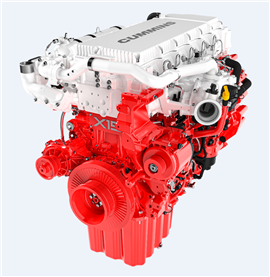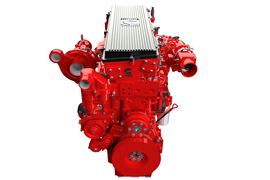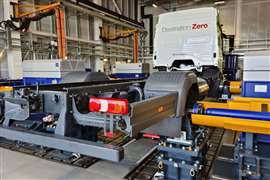Cummins’ Nebergall discusses the future of hydrogen IC engines
08 September 2024
In a July Engine Technology Forum (ETF) webinar about hydrogen internal combustion (IC) engines and decarbonization, Jim Nebergall of Cummins said decarbonization of vehicles and equipment is going to require a variety of approaches. The general manager of Cummins’ hydrogen engine business added that it will take “multiple power solutions, including advanced combustion engines, battery electric and fuel cells. We need diverse solutions.”
Supporting that philosophy is Cummins’ HELM strategy. Standing for “higher efficiency, lower emissions, multiple fuels,” Jane Beaman, who leads Cummins’ on-highway business, said in a video on the company’s website that the approach gives “customers control of how they navigate their own journeys. They can choose the fuel type that works best for them, their businesses and their goals.”
Engines developed as part of the HELM program are engineered so that selecting a fuel type, including hydrogen, requires a minimum number of components to be changed.
“It’s ordered from the factory as a diesel engine or natural gas engine or hydrogen,” Nebergall said in an interview with Power Progress. “So, part of that that investment strategy is to enable us to be nimble and to have more options for the market because we do believe many options will be required to decarbonize.”
 The Cummins X15 engine, which is part of the HELM program. (Photo: Cummins)
The Cummins X15 engine, which is part of the HELM program. (Photo: Cummins)
However, according to Nebergall, two of the HELM program’s engines — a 6.7 L and a 15 L — are both on track to be ready for hydrogen fuel.
“We are testing both of those engines in different places in the world actively today,” he said. “They’re in test cells, and we’re actually testing on four continents at the moment with those two engines.”
Spark-Ignited Experience
Part of what is making these hydrogen engines commercially viable is Cummins’ experience designing spark-ignited IC engines.
“We have over 20 years of history with natural gas spark-ignited engines,” Nebergall said. “So, there are a lot of similarities in the design [for] a natural gas, but also there are differences because it is a different fuel. It has different characteristics.”
Nebergall added there are occasional similarities to diesel engines, as well. For instance, Cummins’ planned use of lean-burn technology for hydrogen IC results in aftertreatment similar to that used in diesel engines.
“That means you have an aftertreatment that looks more similar to diesel, with SCR (selective catalytic reduction) as your NOx (nitrogen oxides) control device, as opposed to natural gas engines, which are stoichiometric, which means equal air and fuel,” he said. “They use a three-way catalyst for NOx control.”
Diesel-Like Solution
In the ETF webinar, Nebergall noted that feedback from end users indicates that hydrogen IC technology is the most similar to diesel in that a hydrogen engine “provides the power, the torque — it can operate in the existing environments and existing equipment.”
One reason for that is direct injection technology.
“That means there’s a fuel injector per cylinder as opposed to a port fuel injected engine where you inject fuel in the intake manifold somewhere upstream and then the fuel is brought into the combustion chamber,” Nebergall told Power Progress, adding that the approach allows the engine to achieve power and torque equivalent to a modern diesel engine.
Heavy-Duty Decarbonization
When it comes to using hydrogen IC engines in the future, Nebergall said that the best applications will be those that are difficult to decarbonize. One such target for early adoption is the heavy-duty truck market.
“Heavy-duty trucks run a lot of miles,” he said. “That means they consume a lot of fuel. But also, heavy-duty trucks are typically owned by a large customer [that] has multiple units. These are companies that typically have ESG (environmental, social and governance) goals, and they’re trying to decarbonize.”
The size of these fleets and their interest in hydrogen can also help address hurdles in the fueling infrastructure.
“We won’t see a network of fueling stations on day one,” Nebergall said. “It takes a long time to develop fueling networks.” He added that the natural gas infrastructure in the U.S., while relatively robust, took about 20 years to develop.
“Large fleets have the ability to do something at their facilities, at their depots, where they can bring in the infrastructure, bring in the fuel,” Nebergall said, adding that this will result in a more private fueling infrastructure at the outset.
“Having it onsite and then having decarbonization goals starts to set up some of the early applications,” he said.
Ag Equipment Applications
Agricultural equipment is another opportunity for hydrogen IC engines. Nebergall cited the letter of intent Cummins signed with Buhler Industries in 2022 to integrate hydrogen IC engines with Versatile tractors.
“There aren’t a lot of choices that are practical in that environment,” he said. “It’s dusty, it’s dirty. Usually, it’s remote. Today, if diesel fuel is brought in, you can bring in hydrogen fuel and it meets the application needs.”
According to Nebergall, a challenge in ag applications is fuel storage.
“It takes a lot of space to store hydrogen fuel, even though it’s compressed and it’s under high pressure and it’s in these carbon fiber tanks,” he said. “It’s a lot of space claim when you compare a gallon of diesel — how much physical space you need to store a gallon of diesel — versus the equivalent energy content in hydrogen.”
Next Steps
Nebergall said that regarding Cummins hydrogen IC engines, there are some additional steps that need to happen prior to launching them commercially.
“We’re narrowing the architectures to be that final solution,” he said. “The next step would be to actually put product into applications, into vehicles, and start gaining real-world experience and then go into production.”
Regulatory support, OEMs interested in the technology and fuel infrastructure are also key to long-term adoption.
“In general, we see the end of the decade as the right time to be planning for the launch of the technology, and that’s what we’re targeting.”
CONNECT WITH THE TEAM







